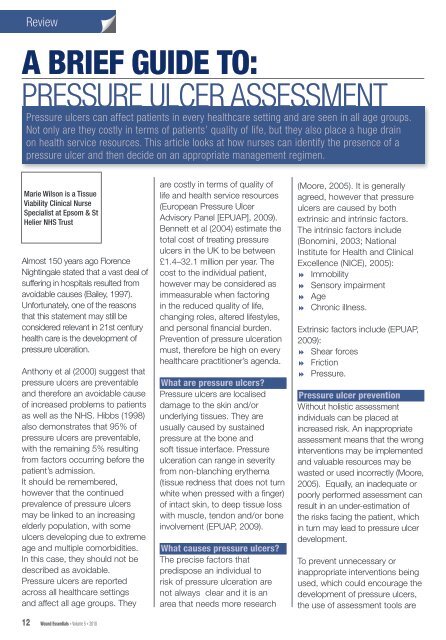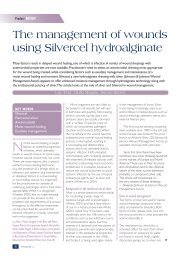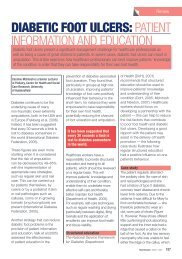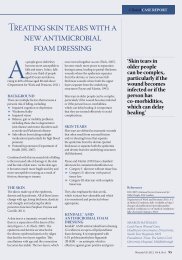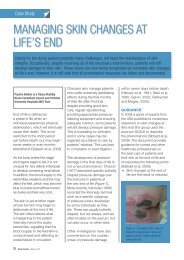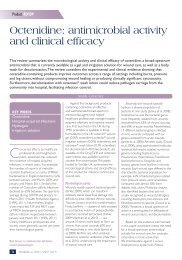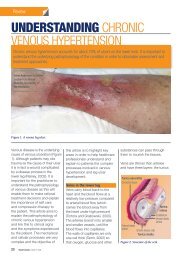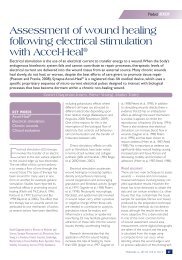a brief guide to: pressure ulcer assessment - Wounds UK
a brief guide to: pressure ulcer assessment - Wounds UK
a brief guide to: pressure ulcer assessment - Wounds UK
Create successful ePaper yourself
Turn your PDF publications into a flip-book with our unique Google optimized e-Paper software.
Review<br />
A BRIEF GUIDE TO:<br />
PRESSURE ULCER ASSESSMENT<br />
Pressure <strong>ulcer</strong>s can affect patients in every healthcare setting and are seen in all age groups.<br />
Not only are they costly in terms of patients’ quality of life, but they also place a huge drain<br />
on health service resources. This article looks at how nurses can identify the presence of a<br />
<strong>pressure</strong> <strong>ulcer</strong> and then decide on an appropriate management regimen.<br />
Marie Wilson is a Tissue<br />
Viability Clinical Nurse<br />
Specialist at Epsom & St<br />
Helier NHS Trust<br />
Almost 150 years ago Florence<br />
Nightingale stated that a vast deal of<br />
suffering in hospitals resulted from<br />
avoidable causes (Bailey, 1997).<br />
Unfortunately, one of the reasons<br />
that this statement may still be<br />
considered relevant in 21st century<br />
health care is the development of<br />
<strong>pressure</strong> <strong>ulcer</strong>ation.<br />
Anthony et al (2000) suggest that<br />
<strong>pressure</strong> <strong>ulcer</strong>s are preventable<br />
and therefore an avoidable cause<br />
of increased problems <strong>to</strong> patients<br />
as well as the NHS. Hibbs (1998)<br />
also demonstrates that 95% of<br />
<strong>pressure</strong> <strong>ulcer</strong>s are preventable,<br />
with the remaining 5% resulting<br />
from fac<strong>to</strong>rs occurring before the<br />
patient’s admission.<br />
It should be remembered,<br />
however that the continued<br />
prevalence of <strong>pressure</strong> <strong>ulcer</strong>s<br />
may be linked <strong>to</strong> an increasing<br />
elderly population, with some<br />
<strong>ulcer</strong>s developing due <strong>to</strong> extreme<br />
age and multiple comorbidities.<br />
In this case, they should not be<br />
described as avoidable.<br />
Pressure <strong>ulcer</strong>s are reported<br />
across all healthcare settings<br />
and affect all age groups. They<br />
are costly in terms of quality of<br />
life and health service resources<br />
(European Pressure Ulcer<br />
Advisory Panel [EPUAP], 2009).<br />
Bennett et al (2004) estimate the<br />
<strong>to</strong>tal cost of treating <strong>pressure</strong><br />
<strong>ulcer</strong>s in the <strong>UK</strong> <strong>to</strong> be between<br />
£1.4–32.1 million per year. The<br />
cost <strong>to</strong> the individual patient,<br />
however may be considered as<br />
immeasurable when fac<strong>to</strong>ring<br />
in the reduced quality of life,<br />
changing roles, altered lifestyles,<br />
and personal financial burden.<br />
Prevention of <strong>pressure</strong> <strong>ulcer</strong>ation<br />
must, therefore be high on every<br />
healthcare practitioner’s agenda.<br />
What are <strong>pressure</strong> <strong>ulcer</strong>s<br />
Pressure <strong>ulcer</strong>s are localised<br />
damage <strong>to</strong> the skin and/or<br />
underlying tissues. They are<br />
usually caused by sustained<br />
<strong>pressure</strong> at the bone and<br />
soft tissue interface. Pressure<br />
<strong>ulcer</strong>ation can range in severity<br />
from non-blanching erythema<br />
(tissue redness that does not turn<br />
white when pressed with a finger)<br />
of intact skin, <strong>to</strong> deep tissue loss<br />
with muscle, tendon and/or bone<br />
involvement (EPUAP, 2009).<br />
What causes <strong>pressure</strong> <strong>ulcer</strong>s<br />
The precise fac<strong>to</strong>rs that<br />
predispose an individual <strong>to</strong><br />
risk of <strong>pressure</strong> <strong>ulcer</strong>ation are<br />
not always clear and it is an<br />
area that needs more research<br />
(Moore, 2005). It is generally<br />
agreed, however that <strong>pressure</strong><br />
<strong>ulcer</strong>s are caused by both<br />
extrinsic and intrinsic fac<strong>to</strong>rs.<br />
The intrinsic fac<strong>to</strong>rs include<br />
(Bonomini, 2003; National<br />
Institute for Health and Clinical<br />
Excellence (NICE), 2005):<br />
8 Immobility<br />
8 Sensory impairment<br />
8 Age<br />
8 Chronic illness.<br />
Extrinsic fac<strong>to</strong>rs include (EPUAP,<br />
2009):<br />
8 Shear forces<br />
8 Friction<br />
8 Pressure.<br />
Pressure <strong>ulcer</strong> prevention<br />
Without holistic <strong>assessment</strong><br />
individuals can be placed at<br />
increased risk. An inappropriate<br />
<strong>assessment</strong> means that the wrong<br />
interventions may be implemented<br />
and valuable resources may be<br />
wasted or used incorrectly (Moore,<br />
2005). Equally, an inadequate or<br />
poorly performed <strong>assessment</strong> can<br />
result in an under-estimation of<br />
the risks facing the patient, which<br />
in turn may lead <strong>to</strong> <strong>pressure</strong> <strong>ulcer</strong><br />
development.<br />
To prevent unnecessary or<br />
inappropriate interventions being<br />
used, which could encourage the<br />
development of <strong>pressure</strong> <strong>ulcer</strong>s,<br />
the use of <strong>assessment</strong> <strong>to</strong>ols are<br />
12 Wound Essentials • Volume 5 • 2010
Review<br />
advocated within NHS trusts,<br />
including Waterlow, Nor<strong>to</strong>n and<br />
Braden risk <strong>assessment</strong> scales.<br />
These <strong>to</strong>ols are supported by the<br />
Department of Health, the RCN,<br />
and NICE (NICE, 2005).<br />
Such <strong>to</strong>ols act as a prompt,<br />
allowing nurses <strong>to</strong> recognise<br />
the risk of <strong>pressure</strong> <strong>ulcer</strong><br />
development by identifying<br />
a range of fac<strong>to</strong>rs (such<br />
as nutritional status, age,<br />
continence, tissue type etc),<br />
which are known <strong>to</strong> influence<br />
the development of <strong>pressure</strong><br />
<strong>ulcer</strong>ation.<br />
It is important that when<br />
completing any formal risk<br />
<strong>assessment</strong> <strong>to</strong>ol the nurse also<br />
uses her clinical judgement — this<br />
will ensure the <strong>to</strong>ol is undertaken<br />
adequately (Nor<strong>to</strong>n et al, 1975).<br />
For example, the risk <strong>assessment</strong><br />
<strong>to</strong>ol may be completed with a low<br />
score, however the nurse may<br />
feel that the patient has a greater<br />
risk of <strong>pressure</strong> <strong>ulcer</strong>ation due <strong>to</strong><br />
confusion and/or underlying nonrecorded<br />
pathologies.<br />
It is generally considered that<br />
completing risk <strong>assessment</strong><br />
<strong>to</strong>ols is the sole responsibility<br />
of registered nurses. It could<br />
be argued, however that with<br />
adequate training these <strong>to</strong>ols can<br />
be completed by any member of<br />
the multidisciplinary team (Rycroft<br />
et al, 2000).<br />
All patients should undergo a<br />
<strong>pressure</strong> <strong>ulcer</strong> risk <strong>assessment</strong><br />
within six hours of admission in<strong>to</strong><br />
an acute area of care. This should<br />
be regularly reviewed throughout<br />
their stay (NICE, 2005). This will help<br />
<strong>to</strong> identify those individuals who<br />
are more susceptible <strong>to</strong> <strong>pressure</strong><br />
<strong>ulcer</strong>ation at the earliest stage.<br />
Risk <strong>assessment</strong> <strong>to</strong>ols<br />
Pain<br />
Assessing the patient’s pain<br />
is considered <strong>to</strong> be the most<br />
important element of a <strong>pressure</strong><br />
<strong>ulcer</strong> risk <strong>assessment</strong>. This does<br />
not just mean the pain from an<br />
<strong>ulcer</strong> site itself, but also any<br />
underlying pain that may have an<br />
impact on wound healing.<br />
Any pain experienced previously<br />
may also affect how the<br />
individual’s <strong>ulcer</strong> site may be<br />
approached and it is important<br />
that the nurse enquires about<br />
this. For example, if the patient<br />
seems tense and is recoiling even<br />
before the dressing is <strong>to</strong>uched, a<br />
previous negative experience may<br />
be the cause of this. Pre-dressing<br />
change analgesia may be<br />
required. In some circumstances<br />
simply providing an explanation<br />
and taking the time <strong>to</strong> help the<br />
person relax will suffice.<br />
To aid <strong>assessment</strong>, a pain scale<br />
is often chosen <strong>to</strong> gain some<br />
understanding of the individual’s<br />
level of pain. Pain <strong>assessment</strong><br />
<strong>to</strong>ols are usually based on a sliding<br />
scale of 1–10, with 1 representing<br />
the least pain and 10 representing<br />
the worst. Many are tailored for<br />
specific patient groups, i.e. smiley/<br />
sad faces for children.<br />
It is always important <strong>to</strong> talk <strong>to</strong><br />
the patient and observe his or<br />
her reactions during wound care,<br />
as in some cases it is possible <strong>to</strong><br />
judge an individual’s pain level by<br />
their reaction <strong>to</strong> the intervention/<br />
dressing change. Some<br />
individuals decline analgesia yet<br />
will be visibly in pain, others may<br />
expect pain due <strong>to</strong> their previous<br />
experience, yet with reassurance<br />
be able <strong>to</strong> undergo dressing<br />
change without analgesia.<br />
It is also vital <strong>to</strong> remember<br />
that every individual will have a<br />
different level of <strong>to</strong>lerance <strong>to</strong> pain<br />
— what one patient may consider<br />
<strong>to</strong> be minor irritation may be<br />
agony for another.<br />
Skin<br />
An inspection of a patient’s<br />
skin should be undertaken <strong>to</strong><br />
assess its general condition<br />
and <strong>to</strong> assess if there is any<br />
existing damage. Dry, moist,<br />
undernourished, and fragile/aged<br />
skin is generally more at risk of<br />
<strong>pressure</strong> damage than nourished,<br />
hydrated skin.<br />
The first indication of tissue/<br />
<strong>pressure</strong> damage is often nonblanching<br />
erythema, usually over a<br />
bony region. The use of light finger<br />
<strong>pressure</strong> at these sites is therefore<br />
vital <strong>to</strong> ensure underlying <strong>pressure</strong><br />
damage is recognised. Other<br />
signs <strong>to</strong> look for are localised heat,<br />
induration (hardness), and oedema<br />
(swelling).<br />
When assessing people with a<br />
darker skin pigmentation, the<br />
recognition of erythema can be<br />
difficult. NICE (2001) suggests<br />
observing the skin for any<br />
discolouration or colour changes,<br />
combined with the signs<br />
mentioned above.<br />
Skin care<br />
It is important <strong>to</strong> consider<br />
the care of the skin and that<br />
healthcare professionals can<br />
inadvertently cause damage.<br />
Rubbing the skin <strong>to</strong>o vigorously<br />
may not only result in pain for<br />
the patient, but also damage<br />
<strong>to</strong> the tissue, especially over a<br />
bony region. When assisting the<br />
individual with any aspect of their<br />
care such as washing, always pat<br />
the skin dry and use an emollient<br />
14 Wound Essentials • Volume 5 • 2010
Review<br />
<strong>to</strong> rehydrate any dry skin. Always<br />
question whether the patient<br />
requires a full wash.<br />
Position/mobility<br />
How an individual is sitting/lying<br />
will effect how much <strong>pressure</strong> is<br />
exerted over their <strong>pressure</strong> areas.<br />
This is obviously dependent<br />
on their ability <strong>to</strong> reposition<br />
themselves and their recognition<br />
of the need <strong>to</strong> do so. Patients<br />
who have a sensory impairment<br />
may not have the capacity <strong>to</strong><br />
understand that they need <strong>to</strong><br />
regularly reposition themselves<br />
and following surgery patients<br />
are restricted in the amount of<br />
movement they can undertake.<br />
The repositioning of any patient<br />
should take in<strong>to</strong> consideration<br />
their individual tissue <strong>to</strong>lerance,<br />
any medical his<strong>to</strong>ry and/or<br />
current medical condition, their<br />
level of activity/mobility and<br />
overall treatment outcomes.<br />
If, for example the patient is<br />
undergoing palliative care and<br />
is extremely uncomfortable<br />
in a certain position or being<br />
turned, it may be necessary<br />
<strong>to</strong> minimise the amount of<br />
repositioning for their comfort.<br />
Always remember <strong>to</strong> document<br />
such decisions.<br />
The individual’s general comfort<br />
must be considered as well<br />
as their right <strong>to</strong> decline any<br />
intervention.<br />
Repositioning techniques<br />
All patients should be encouraged<br />
<strong>to</strong> reposition independently when<br />
they are able <strong>to</strong> do so — they<br />
should also be reminded <strong>to</strong> do so<br />
regularly. For those who require<br />
assistance, the repositioning<br />
should take in<strong>to</strong> their account<br />
comfort, dignity and functional<br />
abililty. Any repositioning will be<br />
pointless if the <strong>pressure</strong> is relieved/<br />
redistributed but the patient is<br />
unable <strong>to</strong> function, e.g. placed in a<br />
position where they are unable <strong>to</strong><br />
take on food and fluids.<br />
When repositioning a patient,<br />
manual-handling aids must<br />
be used <strong>to</strong> avoid dragging the<br />
individual across the surface of<br />
the bed/seat as this can cause<br />
tissue damage through shear and<br />
friction. If the individual is <strong>to</strong> remain<br />
in bed, their position should be<br />
changed regularly (at least every<br />
two hours). Patients should be<br />
placed at a 30-degree tilt unless<br />
they have specific neurological<br />
problems, i.e. in the case of a<br />
cerebrovascular accident (CVA)<br />
or stroke, <strong>to</strong> avoid prolonged<br />
<strong>pressure</strong> at bony prominences.<br />
Otherwise the body is positioned<br />
with the aid of pillows in such a<br />
way that the bony areas are raised<br />
off the flat surface.<br />
If a static mattress is being used<br />
it should have <strong>pressure</strong>-reducing<br />
properties. Any dynamic<br />
mattress (these are air-filled,<br />
mo<strong>to</strong>r driven mattresses) should<br />
only be used after appropriate<br />
<strong>assessment</strong>. The use of a<br />
profiling bed can be useful but<br />
nurses must remember the need<br />
for individual <strong>assessment</strong> with<br />
these electric, multi-positioning<br />
beds.<br />
The seating of patients must<br />
also be considered as patients<br />
are at greater risk when seated<br />
compared <strong>to</strong> resting in bed due<br />
<strong>to</strong> the individual placing a larger<br />
weight on a smaller surface area.<br />
Moisture<br />
Fac<strong>to</strong>rs such as high<br />
temperature, excessive<br />
perspiration, oedema, wound<br />
exudate, and incontinence<br />
may all cause excess moisture.<br />
Prolonged exposure <strong>to</strong> moisture<br />
can waterlog and macerate the<br />
skin, softening the connective<br />
tissue and potentially leading <strong>to</strong><br />
<strong>pressure</strong> <strong>ulcer</strong> development.<br />
Nutrition<br />
Good nutrition is essential for<br />
<strong>pressure</strong> <strong>ulcer</strong> prevention and<br />
healing. Individual patients<br />
should be screened and their<br />
nutritional status assessed.<br />
Under-nutrition is a reversible<br />
element of <strong>pressure</strong> <strong>ulcer</strong><br />
development and, as such early<br />
identification and management<br />
of poor nutrition is of crucial<br />
importance (EPUAP, 2009).<br />
Tools such as the Malnutrition<br />
Universal Screening Tool and food<br />
and fluid input and output charts<br />
are all essential in the moni<strong>to</strong>ring of<br />
nutritional intake. Local nutritional/<br />
dietetic policy/<strong>guide</strong>lines should<br />
also be followed. If there is any<br />
doubt relating <strong>to</strong> the <strong>assessment</strong><br />
of a patient’s nutritional status,<br />
a referral should be made <strong>to</strong> the<br />
dietetic department.<br />
Assessment of a <strong>pressure</strong> <strong>ulcer</strong><br />
Ana<strong>to</strong>mic location<br />
It is important <strong>to</strong> establish the<br />
exact position of the <strong>ulcer</strong> site.<br />
The most common sites of<br />
<strong>pressure</strong> <strong>ulcer</strong>ation are shown in<br />
Figure 1.<br />
Dimensions<br />
Measurements should be taken<br />
of the <strong>ulcer</strong>’s length, width<br />
and depth in centimetres. Any<br />
undermining or tunnelling (areas<br />
of the <strong>pressure</strong> <strong>ulcer</strong> that may<br />
not be visible without palpation<br />
[use of the hands] which<br />
16 Wound Essentials • Volume 5 • 2010
Review<br />
Common sites for <strong>pressure</strong> <strong>ulcer</strong>s<br />
Back of<br />
the head<br />
Shoulder Elbow But<strong>to</strong>cks<br />
Heel<br />
Ear Shoulder Elbow Hip Thigh Leg Heel<br />
Elbow Rib cage Thigh Knees Toes<br />
Main ways that <strong>pressure</strong> <strong>ulcer</strong>s arise<br />
Back of<br />
the head<br />
Figure 2. A heel <strong>ulcer</strong> demonstrating<br />
necrotic tissue (black).<br />
now available with measurements<br />
already on them, but a plain swab<br />
can be used and marked with<br />
a pen then measured with tape<br />
measure/ruler later. One other<br />
innovative way <strong>to</strong> measure the<br />
depth of the cavity is <strong>to</strong> count<br />
how many dressings it takes <strong>to</strong><br />
lightly fill the wound.<br />
Tissue type<br />
The type/s of tissue visible in the<br />
wound bed can be directly linked<br />
<strong>to</strong> the <strong>ulcer</strong>’s management. It is<br />
therefore of vital importance that<br />
the nurse is able <strong>to</strong> identify them<br />
correctly. The main tissue types<br />
are necrotic, granulation, epithelial<br />
and sloughy.<br />
Toes<br />
Base of<br />
spine<br />
Shoulder<br />
Necrotic tissue<br />
Necrotic tissue is dead and mainly<br />
black in colour, but may also present<br />
as a greyish/yellow that is visibly<br />
separated from the surrounding<br />
tissue (Figure 2). As this tissue type<br />
often masks underlying <strong>pressure</strong><br />
Heel<br />
But<strong>to</strong>cks<br />
Figure 1. The main areas of <strong>pressure</strong> <strong>ulcer</strong> development.<br />
extend under the surrounding<br />
tissue) should be explored. To<br />
measure the <strong>pressure</strong> <strong>ulcer</strong>, a<br />
tape measure, a tracing grid<br />
and/or pho<strong>to</strong>graphy may be<br />
used. If pho<strong>to</strong>graphy is <strong>to</strong> be<br />
used <strong>to</strong> keep a record of the<br />
<strong>ulcer</strong>, consent must always be<br />
sought first.<br />
To assess the depth of an <strong>ulcer</strong>,<br />
a cot<strong>to</strong>n-tipped probe/swab<br />
can be gently inserted in<strong>to</strong> the<br />
wound bed. These swabs are<br />
Figure 3. Granulation tissue appears as<br />
rolling, red bumps in the wound bed.<br />
18 Wound Essentials • Volume 5 • 2010
Review<br />
damage, areas of necrosis must be<br />
removed <strong>to</strong> allow a full <strong>assessment</strong><br />
of the wound site. If necrotic tissue<br />
is left in situ, the wound is also less<br />
likely <strong>to</strong> heal and the individual may<br />
be placed at risk of infection.<br />
Granulation tissue<br />
Granulation tissue represents new<br />
tissue formation and appears as<br />
rolling, red bumps in the wound<br />
bed (Figure 3).<br />
Epithelial tissue<br />
This is the regeneration of the<br />
epidermis that presents as pale/<br />
dark pinkish skin often looking<br />
like the surface of the <strong>to</strong>ngue.<br />
Sloughy tissue<br />
Sloughy tissue is the accumulation<br />
of dead cellular debris on the<br />
wound bed surface. It presents<br />
as yellow in colour with a fibrous/<br />
sticky appearance combined with<br />
high levels of exudate (Figure 4).<br />
Surrounding skin<br />
The surrounding tissue and<br />
the wound margins all require<br />
observation. Maceration takes<br />
place when it is consistently<br />
wet. The skin softens, turns<br />
white, and can easily become<br />
infected with bacteria. Visible<br />
maceration may indicate a<br />
heavily exuding (draining) <strong>ulcer</strong><br />
site that if left unaddressed<br />
may erode the surrounding<br />
tissue. Any dressing choice<br />
in these cases must take in<strong>to</strong><br />
consideration the level and type<br />
Figure 4. Slough is yellow in colour and<br />
has a fibrous/sticky appearance.<br />
of exudate. A wound should be<br />
moist <strong>to</strong> allow chemicals and<br />
cells <strong>to</strong> migrate (roam freely)<br />
and aid healing, yet an overly<br />
exudating <strong>pressure</strong> <strong>ulcer</strong> will<br />
take longer <strong>to</strong> heal. Equally, in a<br />
dry wound bed cells necessary<br />
<strong>to</strong> healing are unable <strong>to</strong> migrate<br />
and healing is delayed.<br />
Heelift® Suspension Boot<br />
The Pressure-Free Solution<br />
Use it for prevention.<br />
Use it for treatment.<br />
Use it for peace of mind.<br />
This cutaway shows you how<br />
Heelift® literally suspends the<br />
heel in space.<br />
Pressure is transferred <strong>to</strong> the<br />
calf so the heel never makes<br />
contact with the bed.<br />
• If required, Heelift® can be cus<strong>to</strong>mized<br />
by trimming the extra pad <strong>to</strong> meet the<br />
need of any patient<br />
• Use the included extra pad <strong>to</strong> prevent<br />
foot-drop or control hip rotation<br />
• Available in Smooth or Convoluted Foam<br />
• Now also available in Bariatric and Petite<br />
There is only one Heelift®.<br />
MARKETING<br />
St. Peter’s Church • Ubbes<strong>to</strong>n • Halesworth<br />
Suffolk • IP19 0EX • England<br />
Tel: (01986) 798120 • Fax: (01986) 798040<br />
e-mail: info@VMMarketing.co.uk<br />
website: www.VMMarketing.co.uk<br />
© 2010, DM Systems, Inc. All rights reserved. Wound Essentials 2010<br />
moorings mediquip<br />
Moorings Mediquip<br />
Mobility & Independent Living Centre<br />
51 Slaght Road • Ballymena<br />
Co Antrim BT42 2JH • N.Ireland<br />
Tel: +44 28 2563 2777 • Fax: +44 28 2563 2272<br />
e-mail: sales@mooringsmediquip.co.uk<br />
website: www.heelift.co.uk<br />
Heelift ® Patent No. 5449339 & 7,458,948.<br />
WOULD YOU LIKE A SAMPLE<br />
Please use the following link <strong>to</strong> request a<br />
sample, demo DVD, or CD:<br />
www.heelift.com/w<br />
Wound Essentials • Volume 5 • 2010 19
Review<br />
Exudate<br />
There are various types of wound<br />
exudate. Exudate is part of the<br />
normal wound healing process,<br />
presenting as serous fluid in the<br />
wound bed. However, the nature<br />
of exudate changes in chronic<br />
and non-healing wounds and can<br />
become problematic (Table 1).<br />
When attempting <strong>to</strong> clarify the type<br />
of exudate that is present within<br />
a <strong>pressure</strong> <strong>ulcer</strong>, it is important<br />
<strong>to</strong> assess any accompanying<br />
odour. The majority of non-infected<br />
<strong>pressure</strong> <strong>ulcer</strong>s have little or no<br />
odour. If an odour develops over<br />
a period of time it may indicate an<br />
underlying infection. It is important<br />
<strong>to</strong> remember that some dressings<br />
used in the treatment of <strong>pressure</strong><br />
<strong>ulcer</strong>s, such as hydrocolloids, may<br />
give off odour.<br />
Grades<br />
The grade of the <strong>pressure</strong> <strong>ulcer</strong><br />
is another vitally important fac<strong>to</strong>r,<br />
which affects the way in which it<br />
is managed. For example, a grade<br />
1 <strong>ulcer</strong> will require observation,<br />
repositioning and possibly a film<br />
dressing, whereas a grade 4 <strong>ulcer</strong><br />
will require immediate specialist<br />
intervention. The most commonly<br />
used <strong>to</strong>ol <strong>to</strong> aid <strong>pressure</strong> <strong>ulcer</strong><br />
grading is The European Pressure<br />
Ulcer Prevention Scale (EPUAP,<br />
2009), which classifies <strong>ulcer</strong>s as<br />
follows (EPUAP, 2004):<br />
Table 1.<br />
8 Grade 1: Non-blanching<br />
erythema<br />
8 Grade 2: Superficial/partial<br />
dermal thickness wound, e.g.<br />
blister, abrasion<br />
8 Grade 3: Full thickness tissue<br />
damage that extends down <strong>to</strong><br />
the underlying fasciae<br />
8 Grade 4: Full thickness tissue<br />
damage that involves bone,<br />
muscle and underlying<br />
structures.<br />
Conclusion<br />
There are many other fac<strong>to</strong>rs that<br />
are pertinent <strong>to</strong> the individual patient<br />
and that these must be taken in<strong>to</strong><br />
consideration when undertaking<br />
<strong>pressure</strong> <strong>ulcer</strong> risk <strong>assessment</strong>. It is<br />
hoped that this article may be used<br />
as a quick reference <strong>guide</strong>. WE<br />
Anthony D, Reynolds T, Russell L<br />
(2000) An investigation in<strong>to</strong> the use<br />
of serum albumin in <strong>pressure</strong> sore<br />
prediction. J Adv Nurs 32(2): 359–65<br />
Bailey M (1997) Florence<br />
Nightingale and the Nursing Legacy.<br />
Arthanaeum Press, Tyne and Wear<br />
Bennett G, Dealey C, Posnett J<br />
(2004) The cost of <strong>pressure</strong> <strong>ulcer</strong>s<br />
in the <strong>UK</strong>. Age Ageing 33: 230–5<br />
Bonomini J (2003) Effective<br />
interventions for <strong>pressure</strong> <strong>ulcer</strong><br />
prevention. Nurs Stand 17(52):<br />
45–50<br />
Bergstrom N, Braden BJ,<br />
Laguzza A, Holman V (1987).<br />
The Braden scale for predicting<br />
<strong>pressure</strong> sore risk. Nurs Res<br />
36(4): 205–10<br />
EPUAP (2004) The EUPAP Guide<br />
<strong>to</strong> Pressure Ulcer Grading.<br />
EPUAP, Oxford<br />
EPUAP (2009) Prevention and<br />
Treatment of Pressure Ulcers. A<br />
Quick Reference Guide. Available<br />
at: http://www.epuap.org/<br />
<strong>guide</strong>lines/Final_Quick_Prevention.<br />
pdf (accessed 11 May, 2010)<br />
Hibbs PJ (1998) Pressure Area<br />
Care for the City of Hackney<br />
Health Authority. City and<br />
Hackney Health Authority, London<br />
Moore Z (2005) Pressure <strong>ulcer</strong><br />
grading. Nurs Stand 19(52):<br />
56–64<br />
NICE (2001) Inherited Clinical<br />
Guideline B. Pressure Ulcer Risk<br />
Assessment and Prevention.<br />
NICE, London<br />
NICE (2005) Pressure Ulcer<br />
Assessment and Prevention.<br />
NICE, London<br />
Nor<strong>to</strong>n D, McLaren R, Ex<strong>to</strong>n-<br />
Smith AN (1975) An Investigation<br />
of Geriatric Nursing Problems in<br />
Hospital. The National Corporation<br />
for the Care of Old People, London<br />
Various types of wound exudate (adapted from Lipcott et al, 2003)<br />
Description<br />
Colour and consistency<br />
Serous<br />
Clear or light yellow; thin and watery<br />
Sanguinous<br />
Red; thin<br />
Serosanguinous<br />
Pink <strong>to</strong> light red; thin<br />
Purulent<br />
Creamy yellow, green and white; thick<br />
Rycroft-Malone J, McInnes<br />
E (2000) Press Ulcer Risk<br />
Assessment and Prevention.<br />
RCN Publishing, London<br />
Vuolo J, Anderson I, Fletcher<br />
J (2003) Wound Care made<br />
Incredibly Easy. Lipcott Williams &<br />
Wilkins, New York<br />
20 Wound Essentials • Volume 5 • 2010


